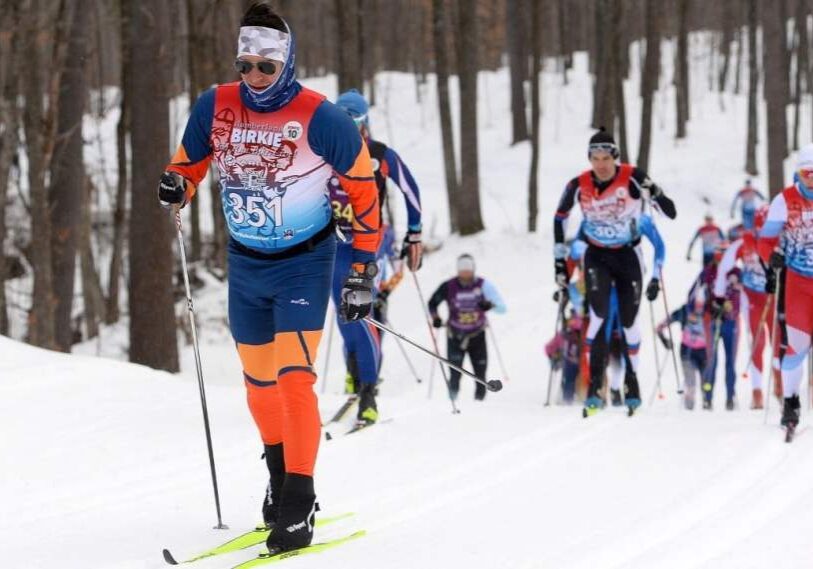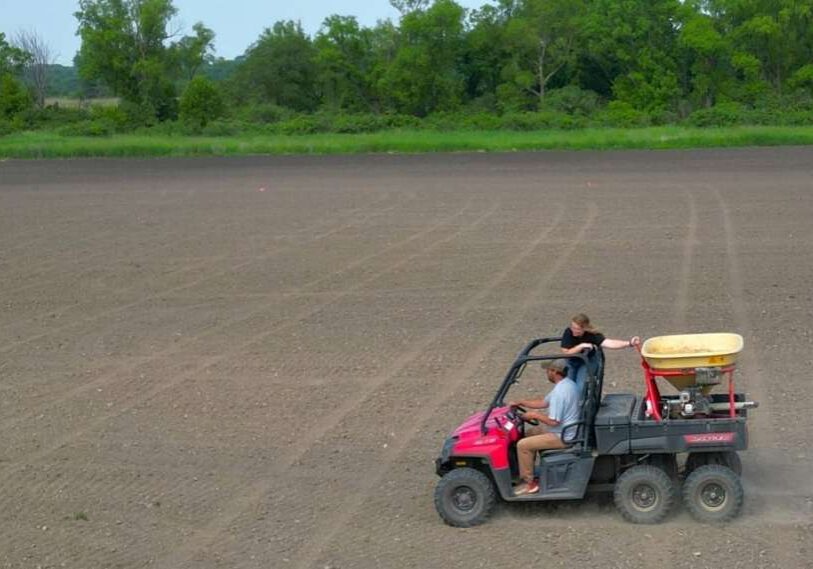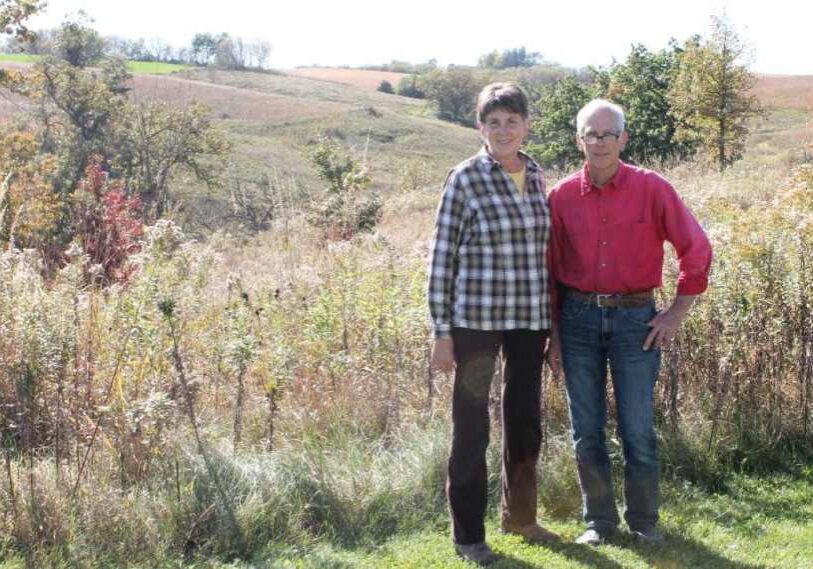Go Fish: The Lanesboro State Fish Hatchery

CARROLTON TOWNSHIP, FILLMORE COUNTY – The entrance into the Lanesboro State Fish Hatchery, about one mile west of town on Highway 16, looks a bit like entering a prison yard. Several non-descript buildings are surrounded by a formidable fence against the backdrop of a high bluff preventing escape on the opposite side of the facility.
The science and biosecurity of the hatchery mandate the fencing. But the bubbling of spring water feeding the fish runs and the friendliness of staff reassures visitors that this is a peaceful and safe environment — one of 15 Minnesota Department of Natural Resources (DNR) fish hatcheries scattered around the state.
I visited this hatchery on a beautiful, sunny day and was given the full tour and story by Hatchery Supervisor Scott Sindelar.
The hatchery sits directly across Duschee Creek from the DNR Area Fisheries Office. Staff in this office survey fish populations in area water bodies and work with the hatchery for stocking fish. They establish a management plan for each stream and water body, which may entail stocking by the hatchery.

Cold water pours out of a spring in the hill bordering the hatchery. (Photo by Renee Bergstrom)
One former hatchery employee said he enjoyed his time at the hatchery — but also revealed that most of the winter the hatchery is shaded due to its location near the bluff, and the parking lot is often covered with ice. It takes extra discipline to care for the tiny fish eggs in the dark while the DNR’s Fisheries Office across the creek basks in sunshine with a dry parking lot!
The message: Crucial groundwork is being done year-round behind a fence, in the dark, through the dead of winter.
Nearly 100 years of growing trout
In the early 1900s fish biologists determined Lanesboro would be an ideal area for trout habitat due to the natural coldwater springs. An old feed mill called the Duschee Mill was purchased by the state and converted into a fish hatchery around 1925.
Originally called the Root River Basin Trout Hatchery, this coldwater hatchery has always produced trout of various strains and species and currently produces Arlee Rainbow Trout, Steelhead and Plymouth Rock Brown Trout.

This Duschee Creek interpretive trail map guides visitors to various sites. (Photo by Renee Bergstrom)
The current Lanesboro Hatchery is the largest coldwater hatchery in Minnesota. Each year the hatchery produces and stocks about 125,000 pounds — some 675,000 fish annually — in over 170 lakes and streams stretching across every region of the state, including Steelhead for Lake Superior.
Why do we need hatcheries? Good question since local residents know that here in southeast Minnesota we have several natural streams and bodies of water providing good habitat for wild species of trout to reproduce.
Minnesota has chosen to supplement existing fish populations statewide for better fishing opportunities — this includes a need to create new wild spawning and self-sustaining populations in certain streams.

Rare albino rainbow trout are kept separate from the rest of the stock. These are not used for reproduction at the hatchery but rather kept for interest to visitors. (Photo by Renee Bergstrom)
Area DNR Fisheries Offices monitor these bodies of water and come up with a management plan to determine where stocking might be beneficial. Their analysis then determines what species, strain, size and numbers our state hatcheries, including Lanesboro’s, need to produce for stocking.
Once the math is complete and stocking begins, fish are loaded into various sized tanks — some of which are over 500 gallons each and can hold up to 800 pounds of fish.
Does economics play a role in all this work? Sure.
A recent study identified a $1.9 billion trout fishing industry in the Driftless Area (this includes southeastern Minnesota, southwestern Wisconsin and northeastern Iowa). The industry supports more than 6500 jobs in this same area.

One of the many long raceways holding thousands of growing trout. (Photo by Renee Bergstrom)
An interesting local sidebar to this industry is that the DNR’s neighboring hatchery near Peterson, just down Highway 16 to the east, is now producing a brook trout unique and native to Minnesota’s Driftless area (studies suggest these trout — occasionally referred to as “heritage brook trout” — may be carrying remnant native Minnesota brook trout genetics); it’s hoped these could be self-sustaining in additional streams throughout this region.
Water quality Is key to healthy fish
While the temperature and volume of spring water from the aquifers is crucial, the monitoring of the water quality is essential.
Water samples are taken daily to make sure the spring water is safe for fish and, at the other end of the hatchery’s process, the effluent discharge into Duschee Creek is clean.

One of the outdoor ponds holding young trout. (Photo by Renee Bergstrom)
Additionally, there is communication with local farmers about how to protect or isolate their sinkholes which can provide easy access to the aquifers from surface runoff containing contaminants, including nitrates and pesticides. This is an ongoing threat in this region’s groundwater and springs.
Other human caused potential hazards to the water quality at the hatchery have included ethanol tanker spills on the curves above the hatchery on Hwy 16 and a well drilled on a nearby homestead that penetrated the aquifer. In the latter instance, drilling fluid entered the spring which feeds the fishponds and raceways (long flow-through channels where fish are protected and raised in moving water). The result was a bubble bath completely filling the biggest raceway building.
(Links to stories about underground aquifers, sink holes and related groundwater contamination can be found at the end of this article.)

Against the pond’s rock bottom, small trout are well camouflaged from above. (Photo by Renee Bergstrom)
This hatchery building contains 12 raceways each measuring 10-feet wide and 100-feet. Fortunately, no fish were harmed in the above incidents. But these are the types of concerns the DNR watches for as they could create major problems for the trout.
The fish spawning process is complicated and takes a close eye at every stage throughout the year.
Our current season, fall, is spawning time and stocking time in lakes ahead of winter ice fishing season.
Winter is centered on egg care and hatching and rearing of young fish.

People are not the only creatures looking for trout! A Great Blue Heron flies over the ponds no doubt looking for a meal. (Photo by Renee Bergstrom)

The Lanesboro State Fish Hatchery welcomes guests Monday through Friday for self-guided tours. (Photo by Renee Bergstrom)
When spring arrives, stocking begins mostly in southern Minnesota in April and moves to northern Minnesota in May after lake ice has melted.
Visiting the hatchery
A great place for kids of all ages to get an up-close look at how fish grow, the Lanesboro State Fish Hatchery is open for self-guided tours Monday through Friday from 7:00 a.m. to 3:30 p.m.
The office has an excellent historical video on the hatchery with more detail on how it works. You can also learn more from this Lanesboro Fish Hatchery Fact Sheet produced by the DNR.
And for all the anglers out there, remember that the next fish you catch may have gotten its start right here at the Lanesboro Hatchery. Go fish and let us know!
Additional articles related to water quality published by Root River Current: Minnesota Launches First Phase of Nitrate Mitigation Plan Southeast Minnesota Runoff Pollutes Beyond Local Area Minnesota Nitrate concerns inspire Iowa groups to seek EPA help Nitrate and Water Issue Proposals Addressed by 2024 Minnesota Legislature State Officials: January 2024 Plan Addresses Nitrate Contamination Issues What Happens When Feedlots Get Bigger in Karst Country? Walk The Walk And Talk The Talk, Too looks at how area farmers are working to achieve their goals for land stewardship, their families and communities. Root Causes, Root Solutions explores a Houston County dairy farmer’s practices to control runoff and soil erosion. Articles related to trout and fishing: Habitat improvements on Chatfield’s Mill Creek Fishing Access Upgraded at Lanesboro’s Historic Dam DNR shocks trout to check health of area streams






